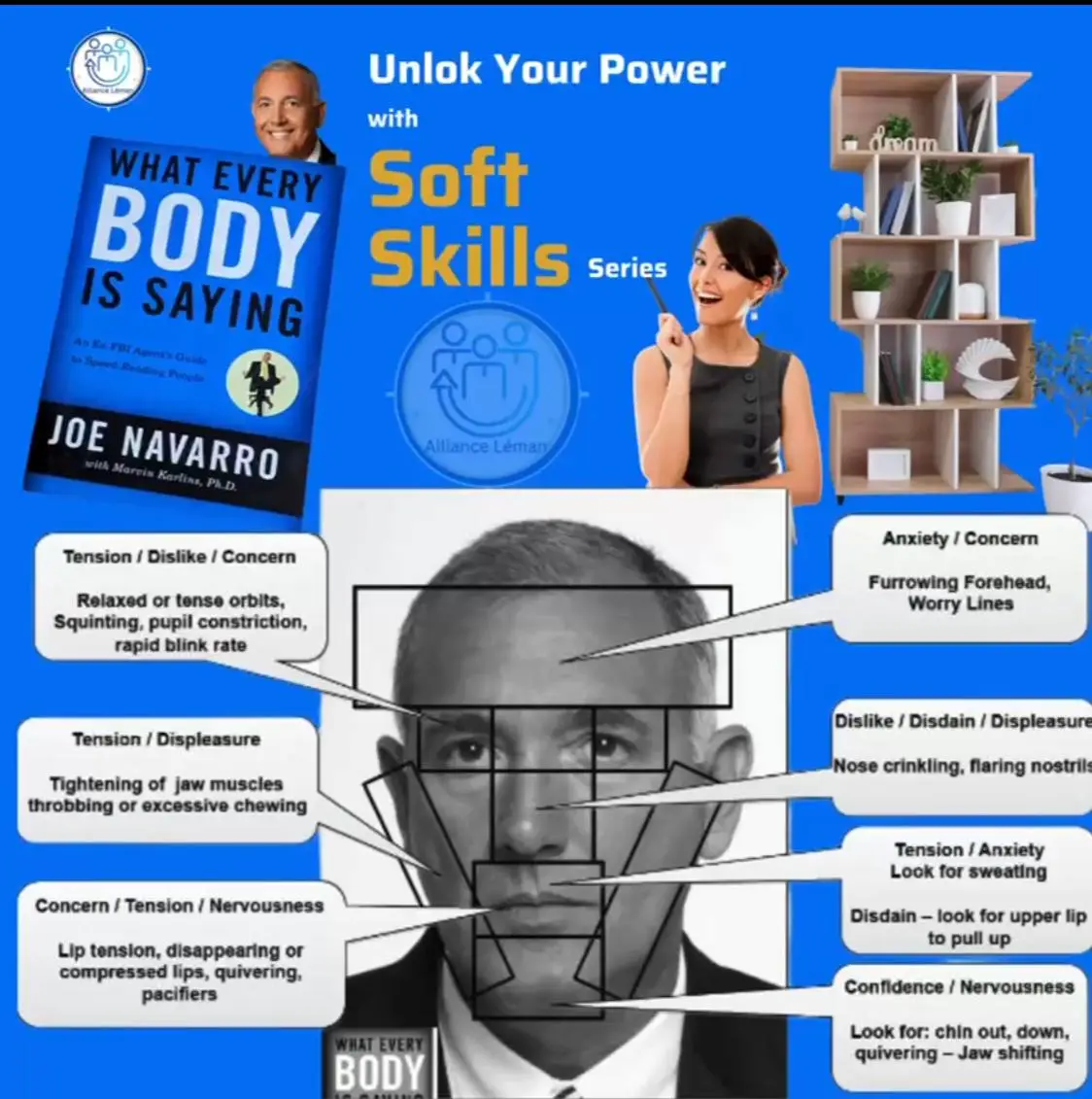
Mastering Nonverbal Communication: Insights from What Every BODY is Saying by Joe Novarro
Author
-

Mojtaba is Alliance Leman’s founding father. With more than 20 years of international experience in small to large scale projects, he writes to provide his insights on topics such as management, business development, and soft skills.
View all posts
In today’s interconnected world, mastering soft skills like effective communication is critical. In What Every BODY is Saying, former FBI agent Joe Navarro takes readers on a fascinating journey through the world of body language and nonverbal cues. With a career rooted in high-stakes observation, Navarro reveals how subtle movements, gestures, and facial expressions can often say more than words. Thus, these insights help us read others’ emotions, intentions, and levels of comfort in any setting.
As part of our soft skills series, this article breaks down Navarro’s core concepts, teaching readers to tune into the often-overlooked language of the body. By learning to decode these nonverbal cues, you can enhance personal and professional relationships, improve negotiation skills, and build empathy—all essential for fostering trust and connection.
Key techniques to understand body language from Joe Navarro
Spot the Power of Nonverbal Cues
Research shows that up to 90% of human communication is nonverbal, which makes body language a powerful tool for interpreting true feelings. By observing gestures, posture, and facial expressions, we gain deeper insights into others’ emotions, often reading beyond what words convey.
Focus on the Limbic Brain’s “Honest Signals”
Navarro highlights the importance of the limbic brain, the center of instinctive and involuntary reactions often referred to as the “honest brain.” Reactions like freezing, sudden movements, or instinctive gestures reveal true emotions, especially in situations of stress or tension. Therefore, these responses are often more reliable than verbal expressions.
Observe Foot and Leg Movements
Feet and legs are especially revealing in social situations. For example, a person turning their feet toward an exit may indicate a desire to leave or discomfort in the conversation. By paying attention to these subtle cues, you can gain insights into others’ comfort levels and intentions.
Watch Hand Movements During Stress
Hands often betray emotions when people are nervous or stressed. Fidgeting, wringing hands, or touching the face can all indicate discomfort. Noticing these behaviors can therefore help us gauge others’ feelings, especially when they’re trying to mask them.
Identify “Pacifying” Behaviors
After experiencing stress, many people engage in comforting behaviors—touching their neck, crossing their arms, or playing with an object—to calm themselves. Recognizing these actions can indicate unease or anxiety, which helps us respond more empathetically.
Tips to avoid bias in your interpretation of body language
Establish Baseline Behaviors
One of the most important steps in interpreting body language is understanding someone’s baseline or natural behavior. Once a baseline is set, it’s easier to spot changes in behavior, which may indicate dishonesty, anxiety, or discomfort.
Check for Consistency Between Words and Actions
When nonverbal cues contradict verbal statements, it’s a signal that something may be amiss. For instance, a person may agree verbally but shake their head slightly, suggesting they may feel differently. Noticing these inconsistencies, then, helps us interpret messages more accurately.
Consider the Context of Behaviors
Body language interpretation isn’t one-size-fits-all; understanding context is essential. A behavior that may signal anxiety in one setting could mean something entirely different in another. Therefore, observing the whole situation is crucial to accurate interpretation.
Remain Flexible and Open-Minded
Navarro advises against rigidly interpreting body language cues. Remaining adaptable and considering multiple possibilities prevents misinterpretation and ultimately helps us respond more thoughtfully.
How body language skills help you
Mastering nonverbal cues is more than just observing—it’s a valuable soft skill that can lead to better communication and connection in both professional and personal relationships. By reading body language effectively, we become more attuned to others’ needs, building empathy and trust, which are foundational to effective teamwork, conflict resolution, and leadership.
Watch our short intro of what every BODY is saying by Joe Novarro below:
Frequently asked questions about body language
1. How does understanding body language improve communication skills?
Mastering nonverbal cues is more than just observing—it’s a valuable soft skill that can lead to better communication and connection in both professional and personal relationships. By reading body language effectively, we become more attuned to others’ needs, building empathy and trust, which are foundational to effective teamwork, conflict resolution, and leadership.
2. Why is the limbic brain central to Navarro’s teachings?
The limbic brain is responsible for involuntary, instinctual responses that are nearly impossible to mask. This makes it an ideal focus for understanding authentic reactions and underlying emotions.
3. Can these skills be useful in professional settings?
Absolutely. Recognizing nonverbal cues enhances negotiation, leadership, and teamwork skills by helping individuals interpret others’ intentions and emotions accurately, ultimately strengthening workplace relationships.
4. Is it difficult to learn body language reading skills?
Like any skill, it requires practice. However, Navarro’s techniques are designed to be accessible and practical, and anyone can improve their observation skills with time and effort.
5. Can nonverbal cues be misleading?
Nonverbal signals should be interpreted alongside context, baseline behavior, and the overall situation. Using these elements together ensures a balanced, accurate understanding.
6. Does What Every BODY is Saying include exercises to practice these skills?
Yes, the book contains examples and exercises that help readers apply these principles, making it a practical resource for honing body language reading skills.
Conclusion: Building your soft skills with body language
Developing body language awareness is a vital addition to anyone’s soft skill set, enabling greater emotional intelligence and communication precision. What Every BODY is Saying by Joe Navarro provides the tools and techniques to decode nonverbal communication, empowering readers to connect more meaningfully and navigate complex social landscapes with confidence.
Read more of our soft skills series :
- Master adaptability for career success- Read here
